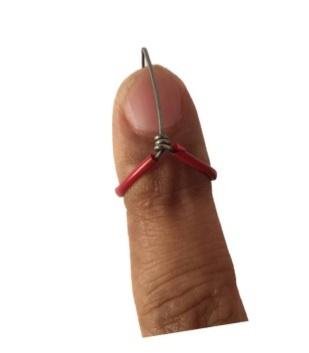When starting sitar, people have lots of questions about the instrument, about tuning, and especially about Indian words relating to music.
Here is a primer on all of these things and a little more. Please note that this document is meant to be used as a reference guide, not a substitute for instruction.
While the definitions included here are exact, the results may not be. Please don’t expect to be 100% in tune, for example, after following this guide, as other factors like ambient humidity, your ear and skill level, the raga being played, etc., all affect sitar tuning.
Wearing a Mizrab:
A mizrab is a steel plectrum worn on the index finger of the right hand. This is our “pick” with which we pluck sitar strings. Please Note that when you first start wearing a mizrab, it will hurt, and your finger will start to form calluses near the first knuckle.
The mizrab should be neither too loose (it shouldn’t shake or change position when you use
Correct position of the mizrab on the index finger
it to strike a string), nor too tight (your finger should not turn purple or be painful when wearing a mizrab). Use common sense when playing and try to find a mizrab that is right for you.
No mizrab is “one size fits all.”
The Strokes of the Sitar:
There are two main right hand strokes used to play the sitar. Rest your right thumb on the neck, with your thumb at the joint between the neck and the gourd. Your fingers should be relaxed and pointed downwards.
The first stroke is called “Da” and is made by closing your fingers towards your hand and striking the main playing string (but do not completely close your fingers into a fist).
Opening your fingers and striking the string on the way down is the “Ra” stroke. Again, fingers come in = Da. Fingers open outwards = Ra.
Da: Fingers coming inward to hit string
Ra: Fingers opening outward to hit string
The Strings of the Sitar:
Here is an image of how you would see a sitar looking down at it, with the upper layer of strings numbered from top (1st string) to bottom (6th string). Note that you will spend 95-99% of your time playing the top, or main string.
This 1st string is also called “Baaj ki taar” in Hindi & Urdu. The word “Baaj” means “Sounding or Speaking,” which explains the name of the string played most often. Baaj ki taar literally translates to “string of playing”. The second string is the thickest string (and the only bronze string) on the sitar, and is called the “Joda ki taar”.
The next two strings are named for the notes to which they are tuned, and the last two (5 and 6) are named “chikari” strings.
| String Number | Indian Tuning (String Name) | Western Tuning (Octave Identification) |
|---|---|---|
Frets and Their Notes:
Frets are the metal bands that separate notes along the body of a sitar. Note that although a fret is technically a metal band across the body, we refer to the area just to the left of a fret when we’re talking about a particular note. This may sound confusing, but it will become clear when you look at the diagram below.
Each note name indicates where a string must be held to produce the sound indicated. For example, the fret to the right of the biggest gap on the body is the “Re” note. Just to the left of this is the “Sa” note. Note that a fret is called a “parda” in Hindi and Urdu.




